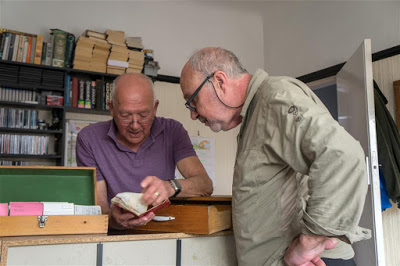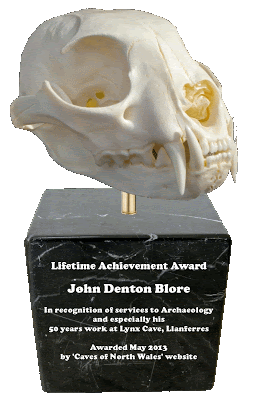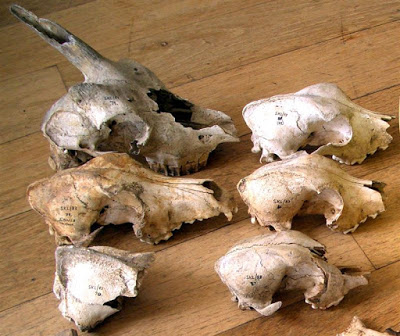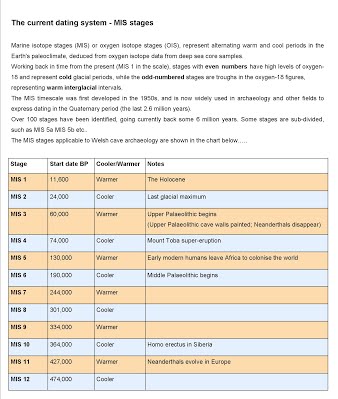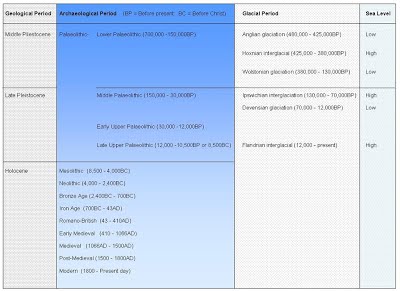------------------------------------------------------------------------------------------------------------
Some 1970s and 1980s primary references
There
are numerous
references to early cave excavations i.e. the first article
on Ffynnon
Bueno Cave was published by Hicks in 1885. In the following three
years he published at least another 12 papers referring to the
cave and 10 more were published by other writers. References to
caves excavated more recently however, particularly those by amateurs,
tend to get overlooked by professionals. Here therefore are a
selection of references relating to excavations carried out since
1962..........
(Main source: Ed Ford, T. (1989) Cave Archaeology in North Wales, in 'Limestones and Caves of Wales')
Abbreviations used:
AW ............ Archaeology in Wales
NWCC ...... North Wales Caving Club
WPCST .... William Pengelly Cave Studies Trust
SWCC ...... South Wales Caving Club
Ffynnon Bueno Cave, Tremeirchion
Davies, M., SWCC, 72, February 1973, Rhinoceros remains in a Flintshire cave
Lloches yr Afr, Llandudno
Davies, M., AW, 13, 1973; AW, 14, 1974; NWCC,
12, November 1973; NWCC, 13, December 1973; NWCC, 19, July, 1974; SWCC,
1978, December 1974; WPCST, 24, January 1975 (with photographs)
Lynx Cave, Llanferres
Blore, J.D., 1965 (unpublished) Lynx Cave, Denbighshire, Preliminary Report 1962-4
Blore, J.D., n.d. Lynx Cave Excavations Clwyd 1962-1981, Second report
Blore, J.D., 2002 The Enigmatic Lynx. ISBN 0 9541835 0 9
Blore, J.D., 2012 Lynx Cave, Denbighshire: 50 years of Excavation 1962 - 2012
North Face Cave,
Llandudno
(Also incorrectly referred to as Ogof Rhiwledyn)
Davies, M., AW, 13, 1973; NWCC, 15, Feb-March 1974.
Blore, J.D., 1977 "Excavations on the Little Orme's Head" (published privately describing work at North Face Cave).
Blore, J.D., 2012 "Archaeological Excavation at North Face Cave, Little Ormes Head, Gwynedd 1962-1976 (updated 2012)"
Ogof Colomendy, Cadole
Carr, E., NWCC, 32, August 1975
Davies, M., NWCC, 32, August 1975; AW, 16,
1976; NWCC, 41, May 1976; NWCC, 49, January 1977; WPCST, 28, January
1977; NWCC, 54, June 1977; WPCST, 29, July 1977; CCC, 4, 1977-8, 18-23,
Ogof Colomendy - Further animal remains and a third human skeleton; AW,
17, 1977.
Ogof 'Corkscrew', Llandudno (see under Corkscrew Cave)
David, G.C.., AW, 19, 1979
Ogof Pant y Wennol, Llandudno
Davies, M., AW, 14, 1974; NWCC, 19, July
1974; NWCC, 21, September 1974; NWCC, 24, December 1974; SWCC, 77,
September 1974; SWCC, 78, December 1974; AW, 15, 1975; NWCC, 32, August
1975;NWCC, 35, November 1975; SWCC, 81, December 1975;WPCST, 25,
September 1975 (with plan); AW, 16, 1976;
WPCST, 28, January 1977; WPCST, 29, July 1977; Stone, T.A. & Smith, B., AW, 19, 1979.
Ogof Tan y Bryn,
Llandudno
Davies, M., AW, 15, 1975; NWCC, 30, June 1975; SWCC, 81, December 1975.
Ogof Tudno,
Llandudno
Stone, T.A., AW, 15, 1975.
Davies, M., NWCC, 32, August 1975; NWCC, 35, November 1975.
Stone, T.A., AW, 16, 1976.
Upper Kendrick's Cave,
Llandudno
Davies, M., AW, 15, 1975; NWCC, 60, December 1977.
Davies, M. & Stone, T.A., WPCST, 31, March 1978 (with figures).
Davies, M., AW, 18, 1978; AW, 19, 1979; WPCST, 32, February 1979, pp 7-9; Studies in Speleology, 1983, IV, 45-52, The Excavation of Upper Kendrick's cave, Llandudno, Studies in Speleology, 1988.
Stone, T.A. & Davies, M., AW, 17, 1977.
Gillespie, R., et al. (1985). Radiocarbon dates from the Oxform AMS system. Archaeometry Date list 2, 27 part 2, 237-46.
---------------------------------------------------------------------------------------------------------------------
Suggested amateur projects
Whilst the
digging of archaeological cave deposits is not to be condoned by those without
archaeological experience, there are many other projects for the keen
amateur. Here are just a few:
1) Artifact deposit database
Bones and other artifacts found in our
local
caves now lie in a multitude of depositories, many in museums, others in
private hands. Many have changed hands over the last century or
two. Some have been lost or even thrown away. There is no
national database describing human remains from Museums in the UK. The
last published
attempt to locate some of the well-distributed artifacts was
over 40 years ago
(Valdemar & Jones 1970). In view of the advances
in analytical techniques, the
importance of these artifacts has grown significantly. There is
therefore a need for an up-to-date database of the finds from each cave
site to confirm where they are now held, and made freely
available
on-line.
2) On-line primary excavation reports
Due to the large number of secondary (and
sometimes conflicting) documentary sources, all primary sources need to
be drawn together for conversion to digital format and
made available on-line. The original excavation reports would then serve as a good starting point for future research.
3) Searching for 'new' archaeological caves
Over the last 50 years or so, approximately
140 'new' caves have been discovered, bringing the north Wales total
to over 200. Many of these have archaeological potential. Boyd
Dawkins discovered several caves in a few days at Llandegla, simply by
excavating badger or fox holes where they could be found at the base of
limestone outcrops. Two more undocumented caves have been found in
recent years in this same area. Such caves typically have their
entrances plugged with earth or more rarely, with glacial debris-flow
material. There is nothing to prevent anyone from carrying out limited
excavation, at least until interesting remains are found. Then,
either call in the professionals or an experienced amateur, to assess
the potential importance of the site. Since the hey-day of the Victorian excavators, most subsequent archaeological caves
were originally discovered and reported by amateur cave archaeologists
or responsible cavers.
Professionals
still (in 2019) provide no guidance whatsoever to cavers or advice on
care to be taken whilst digging to extend a cave.
4) Internal cave surveys
Modern-day professional archaeologists have
not carried out internal surveying of archaeological caves except at
Pontnewydd Cave, Ffynnon Bueno Cave and one or two others. T
here
is therefore an opportunity to carry out a co-ordinated surveying
programme to record all 45 or so archaeological caves. Surveys were
rarely drawn up at the time of original excavations, hence a new survey
project could provide a standardised and more complete record of these
important sites.
5) Searching for cave art
A systematic examination of north Wales'
caves could be carried out by anyone equipped simply with camera,
light-source and a good eye. Although the UKs cave art examples comprise
only engravings, free software is now available designed to highlight
the faintest pigments (see Page 19: Cave Art for more information).
-------------------------------------------------------------------------------------------------------
William Boyd Dawkins
& the Victorian Science of Cave Hunting
Published
in 2017 by Mark White
This is the first book on
the life and work of Dawkins. It is a detailed assessment of his work with a thorough
analysis of the controversial Cresswell Crags affair.
William Boyd Dawkins
features frequently in the literature of North Wales' archaeological caves.
According to his own accounts, he was involved at many caves, although it
appears he was actually in charge of less excavations than those he may have
been invited to inspect. The following is not a precis of White's book, but
instead provides a few quotes from the book by people who knew the man
personally, together with a few comments by the author himself, Mark White. Together
they provide just an impression of the character of a man of his time.
Notes
and quotes from the book
By
the people who knew him.....
Dawkins was born in 1837 at
Buttington parsonage, Montgomeryshire, Wales. He did not have the double-barrelled
name Boyd-Dawkins, as often quoted.
“By the age of ten he claimed to have explored the limestone caves at
Llanymynech Ogof, Montgomeryshire” (page 7).
He was a scholar at Oxford,
where “he was full of pomp and
self-importance”. Entering his thirties “he began to display a confrontational side that hitherto, publicly at
least, had remained hidden from view” (page 34).
Early in his career he
worked for the Geological Survey, although his heart may have been elsewhere, as when he left after nine years, it was with a
reputation of "a poor field worker”
as summed up by Searles V. Woods: “I was not surprised to find that his work
was all put aside at Jermyn Street and fresh geologists put on to do it all
over again” (pages 21, 22). A member of the Geological Society even
described him as “an impudent brute”
(page 50).
He did however, subsequently
produce some very good work, he “excelled
at taxonomy” and “his knowledge of
fossils was exemplary, as a palaeontologist he was top of his field”. In
1863 he published six papers that first identified six different species of
rhinoceros, “which, for the most part,
are still accepted today” (page 26). In 1869, after ten years of intensive
work, he published a paper on British fossil mammals which included tabulated
data on every museum and private collection available in the whole of Great
Britain (pages 33, 34). At this time he first began work as curator of
Manchester Museum, where he began working on collections which “once first rate, were in a wretched state”
(page 41).
“…..
Dawkins never developed a completely satisfactory system of on-site recording
and his excavation methods were crude, although by no means unusual for this
period” (page 12). Despite this he claimed his methods were ‘sufficiently
accurate to satisfy the demands of scientific research’. This overconfidence in
such imprecise methods is a characteristic of all Dawkins’ field
investigations, and would be to his lasting cost
”
(page 13).
Dawkins wrote “many highly opinionated assessments of books
by Darwin, Lubbock and lectures by Huxley” and he wrote an anonymous and
scathing review of ‘The Descent of Man’, published in 1871 by Darwin, “describing the theory of natural selection
as ‘hopelessly inadequate’ preferring his religious beliefs received from his
upbringing in Wales” (page 44).
“While he may have exuded warmth and friendship when he chose, those who
crossed him found a very different persona lurking just beneath the surface”
(page 47). He was also thought to be 'arrogant and dogmatic'” (page 232).
An obituary to Dawkins in 1929 praises the man but also described him as “a lobster with a vengeance” (page 235).
Mark White in his book here
being quoted considers Dawkins was “probably
a liar and a cheat” (page 216).
Despite any shortcomings,
throughout his life he campaigned to improve the working life of miners (page
46).
Boyd Dawkins in North Wales
Having been sent a box of
bones by Charles Darwin (sent to Darwin by a landowner at Llandegla), Dawkins
spent the summer and autumn of 1869 at the caves of Perthi Chwareu, near
Llandegla. "Dawkins' account tells
that after making enquiries he was given permission to excavate and the use of
a free workforce by the landowner, Edward Lloyd. Judging from Lucas's detailed
reconstruction of events (see Lucas, Peter 2007 on Bibliography page) however, the whole venture was more likely
instigated and organised by Mrs Lloyd, who then asked Dawkins to visit".
During the Llandegla work, Dawkins "was
compelled to go away, and the work at the most productive cave was carried on
by Mrs Lloyd, who 'excavated to a distance of 28 feet from the entrance in the
space of six days'" (page 52). The team excavated at Llandegla between
1969 and 1872.
In 1969 news reached Dawkins
of human remains being found in a cairn at Cefn Estate beside the river Elwy,
and this led to his exploration of Cefn Cave, Old Cefn Cave and Pontnewydd
Cave. "I am off to fish in the Elwy
for salmon and trout, and in caves.... for more bones" Dawkins told a
friend in 1871 (page 53).
After his first visit to
Cefn, "Dawkins diaries record nine
visits between 1870-1877, some of which lasted ten days. Precisely what Dawkins
did in the Cefn Caves is unknown, beyond a single reference in 'Cave Hunting'......
what we do know is that Dawkins was confused about which finds came from which
cave. His version contradicted the original accounts of Stanley and is in error,
but is still the most often cited" (page 54).
Several documentary sources
state that Dawkins was responsible for the first excavations at the nearby Pontnewydd
Cave, and for missing artefacts found later when re-examining the early waste
tips. It appears however, that this may not have been the case: "When McKenny Hughes and Rev. Thomas began
their work at Pontnewydd in 1874, they noted that 25 yards of sediment had
already been removed from the cave. This has often been assumed to been largely
Dawkins doing. That Hughes and Thomas found felstone artefacts and a human
tooth in the spoil thrown out by earlier workers is certainly consistent with
the supposition that Dawkins was involved......... Yet there are good reasons
to believe that Dawkins has been unfairly accused of despoiling the entrance to
Pontnewydd. In the opening sentence of their first report, Hughes and Thomas stated
in perfectly plain terms and with no room for misunderstanding that it was the
landowner Mr Williams Wynn who had partly excavated the cave 'some years ago'.
This refers to Herbert Watkin Williams Wynn (1822-1862), husband of Anna, which
dates the work to sometime before his death in 1862. They did not mention
Dawkins once in relation to earlier clearances". "Judging by his (Dawkins') phenomenal output, he would certainly have
published a full account had he been in charge, and if he had been the first to
explore the cave, he would not have been shy in saying so" (pages 54,
55).
White's book is a must-have
for anyone wishing to know more about this interesting character and his work.
--------------------------------------------------------------------------------------------------------------------------
-----------------------------------------------------------------------------------------------------------------------------------------------------------------
